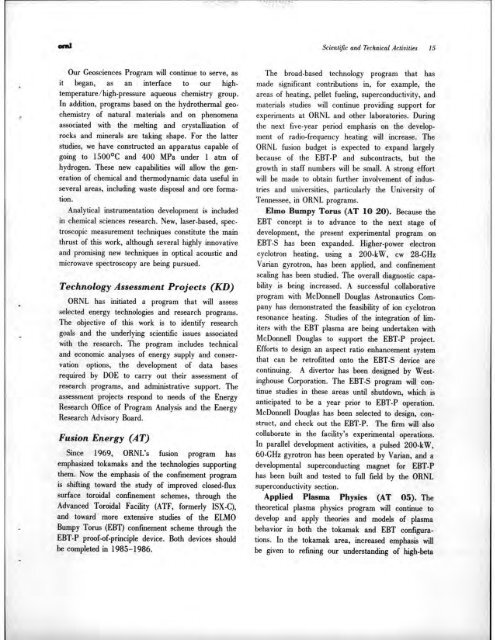Oak Ridge National Laboratory Institutional Plan: FY 1982-1987
Oak Ridge National Laboratory Institutional Plan: FY 1982-1987
Oak Ridge National Laboratory Institutional Plan: FY 1982-1987
You also want an ePaper? Increase the reach of your titles
YUMPU automatically turns print PDFs into web optimized ePapers that Google loves.
Our Geosciences Program will continue to serve, as<br />
it began, as an interface to our high-<br />
temperature/high-pressure aqueous chemistry group.<br />
In addition, programs based on the hydrothermal geo<br />
chemistry of natural materials and on phenomena<br />
associated with the melting and crystallization of<br />
rocks and minerals are taking shape. For the latter<br />
studies, we have constructed an apparatus capable of<br />
going to 1500°C and 400 MPa under 1 atm of<br />
hydrogen. These new capabilities will allow the gen<br />
eration of chemical and thermodynamic data useful in<br />
several areas, including waste disposal and ore forma<br />
tion.<br />
Analytical instrumentation development is included<br />
in chemical sciences research. New, laser-based, spec-<br />
troscopic measurement techniques constitute the main<br />
thrust of this work, although several highly innovative<br />
and promising new techniques in optical acoustic and<br />
microwave spectroscopy are being pursued.<br />
Technology Assessment Projects (KD)<br />
ORNL has initiated a program that will assess<br />
selected energy technologies and research programs.<br />
The objective of this work is to identify research<br />
goals and the underlying scientific issues associated<br />
with the research. The program includes technical<br />
and economic analyses of energy supply and conser<br />
vation options, the development of data bases<br />
required by DOE to carry out their assessment of<br />
research programs, and administrative support. The<br />
assessment projects respond to needs of the Energy<br />
Research Office of Program Analysis and the Energy<br />
Research Advisory Board.<br />
Fusion Energy (AT)<br />
Since 1969, ORNL's fusion program has<br />
emphasized tokamaks and the technologies supporting<br />
them. Now the emphasis of the confinement program<br />
is shifting toward the study of improved closed-flux<br />
surface toroidal confinement schemes, through the<br />
Advanced Toroidal Facility (ATF, formerly ISX-C),<br />
and toward more extensive studies of the ELMO<br />
Bumpy Torus (EBT) confinement scheme through the<br />
EBT-P proof-of-principle device. Both devices should<br />
be completed in 1985-1986.<br />
Scientific and Technical Activities 15<br />
The broad-based technology program that has<br />
made significant contributions in, for example, the<br />
areas of heating, pellet fueling, superconductivity, and<br />
materials studies will continue providing support for<br />
experiments at ORNL and other laboratories. During<br />
the next five-year period emphasis on the develop<br />
ment of radio-frequency heating will increase. The<br />
ORNL fusion budget is expected to expand largely<br />
because of the EBT-P and subcontracts, but the<br />
growth in staff numbers will be small. A strong effort<br />
will be made to obtain further involvement of indus<br />
tries and universities, particularly the University of<br />
Tennessee, in ORNL programs.<br />
Elmo Bumpy Torus (AT 10 20). Because the<br />
EBT concept is to advance to the next stage of<br />
development, the present experimental program on<br />
EBT-S has been expanded. Higher-power electron<br />
cyclotron heating, using a 200-kW, cw 28-GHz<br />
Varian gyrotron, has been applied, and confinement<br />
scaling has been studied. The overall diagnostic capa<br />
bility is being increased. A successful collaborative<br />
program with McDonnell Douglas Astronautics Com<br />
pany has demonstrated the feasibility of ion cyclotron<br />
resonance heating. Studies of the integration of lim-<br />
iters with the EBT plasma are being undertaken with<br />
McDonnell Douglas to support the EBT-P project.<br />
Efforts to design an aspect ratio enhancement system<br />
that can be retrofitted onto the EBT-S device are<br />
continuing. A divertor has been designed by West-<br />
inghouse Corporation. The EBT-S program will con<br />
tinue studies in these areas until shutdown, which is<br />
anticipated to be a year prior to EBT-P operation.<br />
McDonnell Douglas has been selected to design, con<br />
struct, and check out the EBT-P. The firm will also<br />
collaborate in the facility's experimental operations.<br />
In parallel development activities, a pulsed 200-kW,<br />
60-GHz gyrotron has been operated by Varian, and a<br />
developmental superconducting magnet for EBT-P<br />
has been built and tested to full field by the ORNL<br />
superconductivity section.<br />
Applied Plasma Physics (AT 05). The<br />
theoretical plasma physics program will continue to<br />
develop and apply theories and models of plasma<br />
behavior in both the tokamak and EBT configura<br />
tions. In the tokamak area, increased emphasis will<br />
be given to refining our understanding of high-beta

















